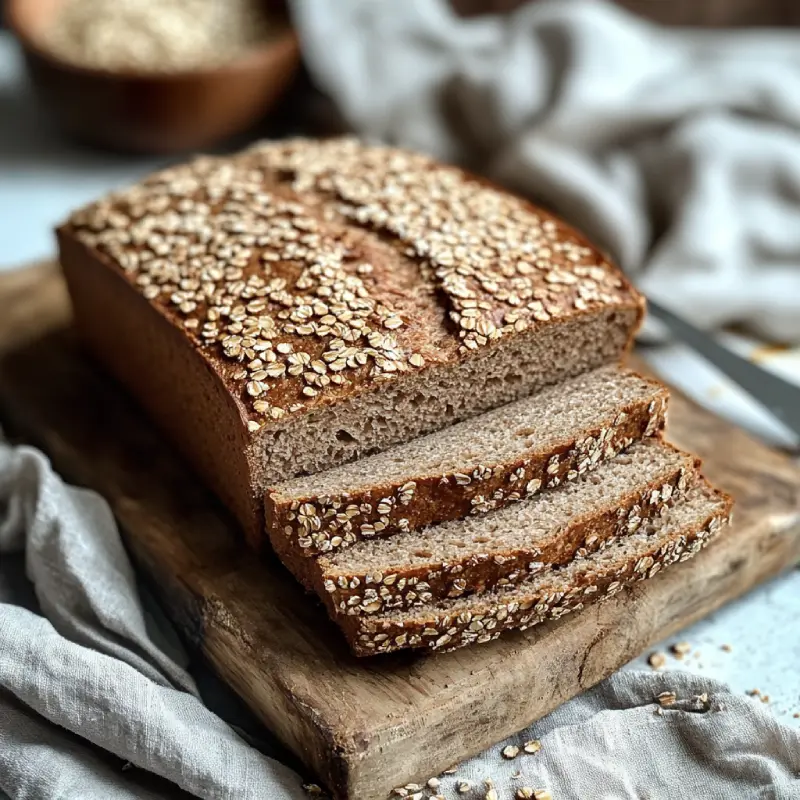Introduction
Buckwheat is a nutrient-rich pseudocereal that has gained popularity as a gluten-free alternative to traditional grains. Unlike wheat, buckwheat is not a grass but a seed that belongs to the rhubarb family. It is packed with essential nutrients, including fiber, protein, and antioxidants, making it a fantastic choice for those looking to enhance their diet. The high fiber content aids digestion, while the antioxidants help combat oxidative stress in the body.
As health-conscious eating trends continue to rise, buckwheat bread has become a favorite among those seeking nutritious and delicious options. This bread is not only gluten-free but also offers a unique, earthy flavor that pairs well with various toppings and spreads. Its dense texture makes it perfect for toasting or serving alongside soups and salads.
What is Buckwheat?
Buckwheat (Fagopyrum esculentum) is a unique pseudocereal that is often mistaken for a grain but is actually a seed from the flowering plant family. It is commonly used in various culinary applications, especially in Asian cuisine, where it is ground into flour for making noodles, pancakes, and bread.
Nutritional Information
- Gluten-Free: Buckwheat is naturally gluten-free, making it an excellent choice for those with gluten intolerance or celiac disease.
- High in Fiber: It is rich in dietary fiber, which aids digestion and helps maintain a healthy gut.
Health Benefits
Incorporating buckwheat into your diet can provide numerous health benefits, including:
- Heart Health: The fiber content helps lower cholesterol levels, promoting cardiovascular health.
- Blood Sugar Control: Buckwheat has a low glycemic index, making it suitable for managing blood sugar levels.
- Rich in Antioxidants: Buckwheat contains flavonoids, which have anti-inflammatory properties and can help protect against chronic diseases.
Why Choose Buckwheat Bread?
Buckwheat bread offers several advantages over traditional wheat bread, making it a compelling choice for many:
Advantages Over Traditional Wheat Bread
- Gluten-Free: Ideal for those with gluten sensitivities or celiac disease, allowing everyone to enjoy bread without health concerns.
- Nutrient-Dense: Buckwheat is packed with vitamins and minerals, offering more nutritional benefits than conventional bread.
Flavor Profile and Texture
- Unique Taste: Buckwheat bread has a slightly nutty flavor that pairs well with both sweet and savory toppings.
- Dense Texture: The bread tends to be denser and more filling than regular bread, making it satisfying.
Dietary Considerations
- High Protein: Buckwheat contains more protein than many other grains, contributing to muscle health and overall wellness.
- Rich in Essential Amino Acids: It includes all nine essential amino acids, making it a complete protein source for vegetarians and vegans.
By choosing buckwheat bread, you’re not only making a delicious choice but also a healthier one!
Key Ingredients for Buckwheat Bread
To create delicious buckwheat bread, it’s essential to use the right ingredients. Here’s a list of the key components you’ll need:
Essential Ingredients
- Buckwheat Flour: The primary ingredient, providing the unique flavor and texture. Make sure to use high-quality, finely ground buckwheat flour for the best results.
- Water: Essential for hydrating the flour and activating the yeast. Use lukewarm water to encourage yeast activity.
- Yeast: Active dry yeast is typically used to help the bread rise, giving it a light texture.
- Salt: Enhances flavor and strengthens the dough structure.
Importance of Using High-Quality Ingredients
- Flavor and Texture: High-quality ingredients lead to better flavor and texture, making your buckwheat bread more enjoyable.
- Nutritional Value: Quality ingredients ensure that you’re getting the maximum nutritional benefits from your bread.
Suggestions for Optional Ingredients
- Seeds: Adding sunflower seeds, pumpkin seeds, or chia seeds can provide extra crunch and nutrition.
- Herbs: Fresh or dried herbs like rosemary or thyme can enhance the flavor profile of the bread.
- Spices: Consider adding spices such as cinnamon or nutmeg for a unique twist.
Preparation Steps for Buckwheat Bread
Making buckwheat bread involves a few simple steps. Follow these instructions for the best results:
Step-by-Step Instructions for Making the Dough
- Combine Ingredients:
In a mixing bowl, combine 2 cups of buckwheat flour, 1 teaspoon of salt, and 2 teaspoons of active dry yeast. - Add Water:
Gradually add 1 cup of lukewarm water to the dry ingredients, mixing until a dough forms. - Knead the Dough:
Transfer the dough to a lightly floured surface and knead for about 5-7 minutes until smooth and elastic. - First Rise:
Place the dough in a greased bowl, cover with a damp cloth, and let it rise in a warm area for about 1 hour, or until doubled in size.
Tips for Achieving the Right Consistency and Texture
- Hydration: Buckwheat flour absorbs more water than wheat flour, so adjust the water as necessary to achieve a slightly sticky but manageable dough.
- Kneading: Proper kneading is essential for gluten development, even if buckwheat doesn’t contain gluten; it helps create structure in the bread.
- Resting Time: Allow enough time for the dough to rise properly, as this is crucial for achieving a light texture.
By following these steps, you’ll create a flavorful buckwheat bread that’s perfect for sandwiches, toast, or enjoying on its own!
Baking Instructions for Buckwheat Bread
Once your buckwheat bread dough has risen and is ready, it’s time to bake! Follow these detailed instructions to ensure your bread comes out perfect, with a crusty exterior and a soft interior.
Detailed Instructions for Baking the Bread
- Preheat the Oven:
Begin by preheating your oven to 375°F (190°C). A well-preheated oven is crucial for achieving the right texture in your bread. - Prepare the Baking Pan:
Lightly grease a loaf pan (9×5 inches) with olive oil or line it with parchment paper. This will prevent sticking and make for easy removal. - Shape the Dough:
After the first rise, gently punch down the dough to release any trapped air. Transfer it to a floured surface and shape it into a loaf. - Second Rise:
Place the shaped loaf into the prepared pan. Cover it with a damp cloth and let it rise again for about 30-45 minutes, or until it has doubled in size. - Score the Bread:
Just before baking, use a sharp knife or a bread lame to make a few shallow slashes on the top of the loaf. This allows steam to escape and helps the bread expand properly during baking. - Bake the Bread:
Place the loaf in the preheated oven and bake for 35-40 minutes. The bread is done when it’s golden brown and sounds hollow when tapped on the bottom. - Cool the Bread:
Remove the loaf from the oven and let it cool in the pan for about 10 minutes. Then transfer it to a wire rack to cool completely before slicing.
Tips for Achieving a Crusty Exterior and Soft Interior
- Steam in the Oven: To create a crusty exterior, place a small oven-safe dish filled with water on the bottom rack while the bread bakes. The steam helps develop a nice crust.
- Monitor the Temperature: Use an instant-read thermometer to check the internal temperature of the bread. It should reach about 200°F (93°C) when fully baked.
- Don’t Rush the Cooling: Allow the bread to cool completely before slicing. This helps the moisture redistribute and prevents a gummy texture.
Serving Suggestions for Buckwheat Bread
Buckwheat bread is not only nutritious but also incredibly versatile. Here are some delightful ideas for serving it:
Ideas for Serving Buckwheat Bread
- Toasted:
Toast slices of buckwheat bread to bring out its nutty flavor. Toasting also enhances the texture, making it crispy on the outside while remaining soft inside. - With Spreads:
- Avocado: Spread mashed avocado on top for a healthy and creamy addition.
- Nut Butter: Almond or peanut butter pairs beautifully, adding protein and flavor.
- Hummus: A spread of hummus adds a savory touch, perfect for a light snack.
Recommended Pairings
- Soups:
Buckwheat bread complements a variety of soups, such as creamy tomato soup or hearty vegetable stew. The bread can be used for dipping or as a side to soak up flavors. - Salads:
Serve alongside fresh salads, such as a spinach salad with nuts and feta, to create a balanced meal. - Cheese Platters:
Pair it with a selection of cheeses for a delightful appetizer. The bread’s earthy notes go well with both soft and hard cheeses.
These serving suggestions will enhance your buckwheat bread experience and make every meal more enjoyable!
Variations and Customizations for Buckwheat Bread
Buckwheat bread is highly versatile, allowing for numerous variations and customizations to suit your taste preferences. Here are some delicious ideas to enhance your bread-making experience.
Alternative Recipes Using Different Flavors or Add-Ins
- Nut and Seed Bread:
- Add 1/2 cup of chopped nuts (such as walnuts or almonds) and 1/4 cup of seeds (like sunflower or pumpkin seeds) to the dough for a crunchy texture and added nutrition.
- Herbed Buckwheat Bread:
- Mix in 2 tablespoons of dried herbs (such as rosemary, thyme, or oregano) to the dough. This adds a fragrant flavor that pairs well with savory dishes.
Suggestions for Making the Bread Sweeter or Savory
- Sweet Variations:
- Incorporate 1/4 cup of honey or maple syrup into the dough for a touch of sweetness. You can also add 1/2 cup of dried fruits (like raisins or cranberries) for a fruity twist.
- Savory Additions:
- Mix in 1/4 cup of grated cheese (such as cheddar or feta) for a rich, savory flavor. You can also add 1-2 cloves of minced garlic for a delightful aroma and taste.
By experimenting with these variations, you can create a buckwheat bread that perfectly matches your culinary preferences!
FAQs About Buckwheat Bread Recipe
Here are some common questions about the buckwheat bread recipe that many people have:
- Can I use a different flour instead of buckwheat flour?
Yes, you can substitute with a blend of gluten-free flours, but this may alter the flavor and texture. - How do I store leftover buckwheat bread?
Store it in an airtight container at room temperature for up to 3 days. For longer storage, slice and freeze the bread. - Can I make this bread without yeast?
Yes, you can use baking powder or baking soda as an alternative leavening agent, but the texture will be different. - What can I add to the dough for extra flavor?
Consider adding herbs, spices, or even cheese for a savory twist, or nuts and seeds for added crunch.
Conclusion
In summary, buckwheat bread is a nutritious and versatile option that can easily be customized to suit your taste. With its unique flavor profile and health benefits, it serves as a fantastic alternative to traditional bread. We encourage you to try this recipe and explore various variations to make it your own. Enjoy the process of baking and savor the delicious results!

